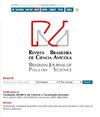Identification of research gaps and systematization of trends on surface treatment in dental implants based on indexed data in the Scopus database
IF 1.1
4区 农林科学
Q3 AGRICULTURE, DAIRY & ANIMAL SCIENCE
引用次数: 0
Abstract
The installation of dental implants brings significant improvements in patient's quality of life, causing the demand for these procedures to increase. This growth results from the increasing use of innovative technologies in oral care. Since the 1970s, dental implants have continuously evolved, both in terms of shape and surface treatments. This evolution aims to improve osseointegration, an essential process for implant success, and prevent complications such as peri-implantitis. A necessary part of this evolutionary process is surface treatment on dental implants. This treatment improves implant surfaces' physical and chemical properties, promoting a more efficient interaction between the implant and surrounding tissues. To achieve this goal, modifications are made to the texture, composition, and characteristics of the implant surface. In this context, this study aims to identify the research gaps related to surface treatment on dental implants. To this end, a literature review was performed in the Scopus database using specific search terms related to this topic. The 20 most cited articles from 2017 to 2023, which address the main research trends in this area, were selected for analysis. The theoretical contribution of this study is to systematize the current research trends on the surface treatment of dental implants. This provides a better understanding of existing treatments and their limitations and presents ongoing studies that aim to overcome them. Furthermore, the research highlights studies under development, both in vitro and in vivo, that seek to apply scientific advances in clinical practice to improve implant outcomes. This applied contribution is relevant, as it can positively impact clinical practice and benefit patients.基于Scopus数据库的索引数据,确定牙种植体表面处理的研究差距和趋势的系统化
种植牙的安装给患者的生活质量带来了显著的改善,导致对这些手术的需求增加。这种增长是由于在口腔护理中越来越多地使用创新技术。自20世纪70年代以来,牙种植体在形状和表面处理方面不断发展。这种进化旨在改善骨整合,这是种植体成功的重要过程,并预防并发症,如种植体周围炎。这一进化过程的一个必要部分是牙种植体的表面处理。这种处理改善了种植体表面的物理和化学性质,促进了种植体与周围组织之间更有效的相互作用。为了实现这一目标,对植入体表面的纹理、组成和特性进行修改。在此背景下,本研究旨在确定与种植体表面处理相关的研究空白。为此,我们使用与该主题相关的特定搜索词在Scopus数据库中进行了文献综述。选取2017年至2023年被引用次数最多的20篇文章进行分析,这些文章阐述了该领域的主要研究趋势。本研究的理论贡献是将目前种植体表面处理的研究趋势系统化。这提供了对现有治疗方法及其局限性的更好理解,并提出了旨在克服它们的正在进行的研究。此外,该研究还强调了正在进行的体外和体内研究,这些研究试图将科学进步应用于临床实践,以改善植入物的效果。这种应用贡献是相关的,因为它可以积极影响临床实践并使患者受益。
本文章由计算机程序翻译,如有差异,请以英文原文为准。
求助全文
约1分钟内获得全文
求助全文
来源期刊

Brazilian Journal of Poultry Science
农林科学-奶制品与动物科学
CiteScore
1.80
自引率
9.10%
发文量
60
审稿时长
>12 weeks
期刊介绍:
A Revista Brasileira de Ciência Avícola surgiu em 1999 a partir da necessidade que a comunidade científica possuía de um periódico para veiculação e publicação de seus trabalhos, com a publicação de três números anuais.
A Revista conta hoje com um corpo editorial altamente qualificado e com artigos científicos desenvolvidos pelos maiores especialistas da área, o que a cada dia atrai mais leitores em busca de inovação e respaldo técnico.
Devido à credibilidade que conquistou pelos esforços de sus autores, relatores e revisores, a Revista ganhou caráter de coleção, sendo consultada como fonte segura de estudo desenvolvidos na Avicultura.
A partir de 2003 – volume 5 -, a Revista passou a chamar-se Brazilian Journal of Poultry Science, e todos os trabalhos passaram a ser publicados em inglês. No mesmo ano subiu para quatro o número de revistas por volume, ampliando-se assim os trabalhos publicados anualmente.
 求助内容:
求助内容: 应助结果提醒方式:
应助结果提醒方式:


